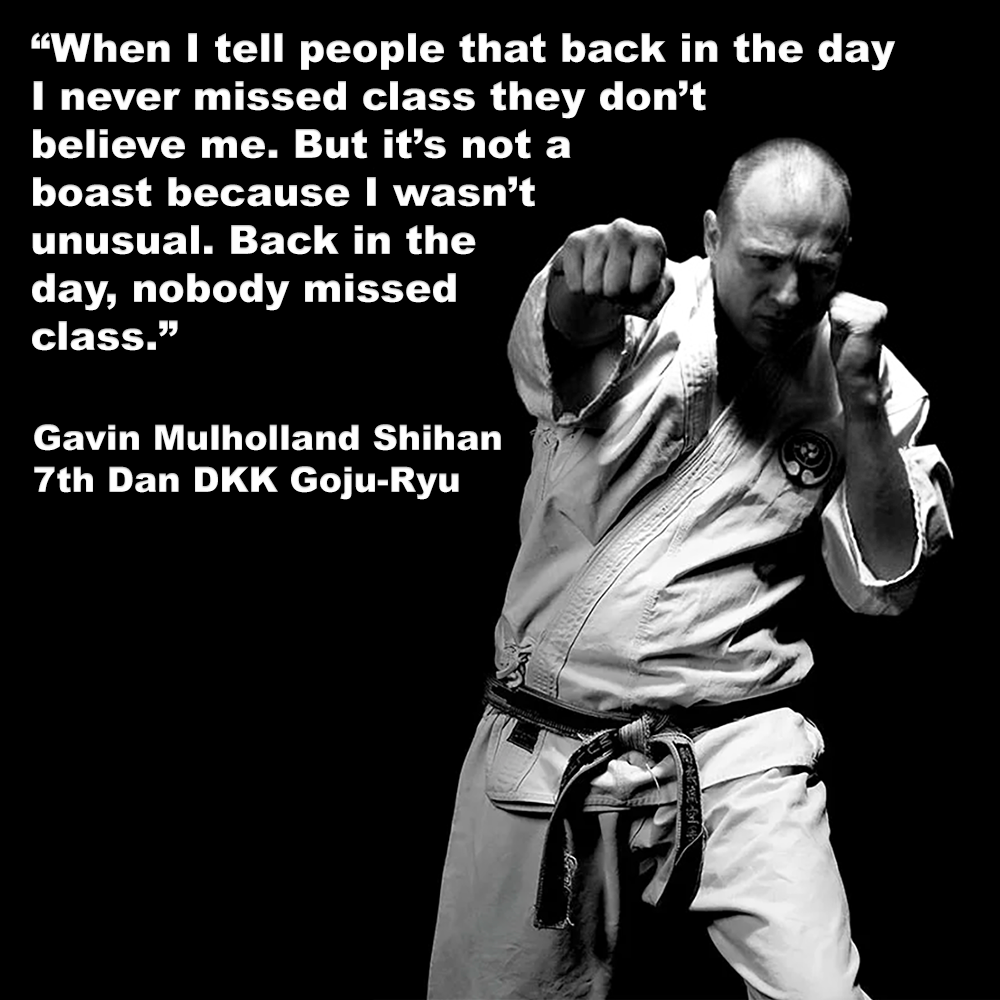
"When I tell people that back in the day I never missed class they don’t believe me."
Posted by ADAM CARTER on NOV 07, 2023

"When I tell people that back in the day I never missed class they don’t believe me."
“When I tell people that back in the day I never missed class they don’t believe me. But it’s not a boast because I wasn’t unusual. Back in the day, nobody missed class.” - Gavin Mulholland Shihan, 7th Dan DKK Goju-Ryu
I too, like Shihan Mulholland, never missed a class. It just wasn’t done. Even if I was injured, I made my way to class. Students were deeply committed to their training, never missing a class, while enduring sometimes extreme rigorous practices.
One of the defining characteristics of early karate training was the unwavering dedication of students. Many practitioners, inspired by the discipline and philosophy of karate and the instructors that introduced us to their art, made a commitment to attend every class without fail. This dedication was driven by a deep respect for the art and the desire to achieve mastery.
Karate training was renowned for its demanding and challenging nature, and instructors pushed their students to the limits, focusing not only on physical conditioning but also on mental and spiritual development.
Training sessions were intense, incorporating a variety of hard hitting techniques, students engaging in rigorous physical exercises to enhance their strength, flexibility, and endurance.
Discipline was a core aspect and students were expected to adhere to strict rules and protocols within the dojo, emphasizing respect for instructors, fellow students, and the art itself. This discipline instilled a strong sense of character and integrity in practitioners, fostering an environment of mutual respect and camaraderie.
Instructors played a pivotal role in shaping the karate community. They served not only as mentors but also as role models, embodying the values of self-discipline, perseverance, and respect. Through their guidance, students learned not only the physical techniques of karate but also the philosophical principles that underpin the martial art.
They demanded excellence, and students respected and revered them. The bonds formed between instructors and students were profound, embodying the traditional master-student relationship.
Perhaps seen by many older karate-ka (like me), a golden era for karate, characterized by a surge in popularity and a dedicated community of practitioners who never missed a class and embraced the challenges of intense training. The discipline, respect, and tough training regimens contributed to the development of skilled martial artists that left a lasting legacy in the world of karate.
Despite the grueling demands of their training, students of this period never missed a class. The physical and mental rigor of karate during these early decades produced self-disciplined, skilled, and resilient martial artists.
It was before the gym culture and multitude of other activities that are taken or left, as the feeling in the moment dictates.
The legacy of this earlier era continues to influence karate practitioners today, emphasizing the enduring value of dedication, self-discipline, and the pursuit of perfection.
Like ancient trees rooted deep in tradition, these dedicated karate practitioners, now revered teachers, stand tall in the dojo, embodying the enduring spirit of discipline and commitment. Their unwavering presence, forged through countless classes and endless dedication, still inspiring generations to come, reminding us that true mastery is not just a destination, but a lifelong journey.
![]() Photo Credit & missing a class quote: Courtesy of Gavin Mulholland Shihan 7th Dan DKK Goju-Ryu
Photo Credit & missing a class quote: Courtesy of Gavin Mulholland Shihan 7th Dan DKK Goju-Ryu
